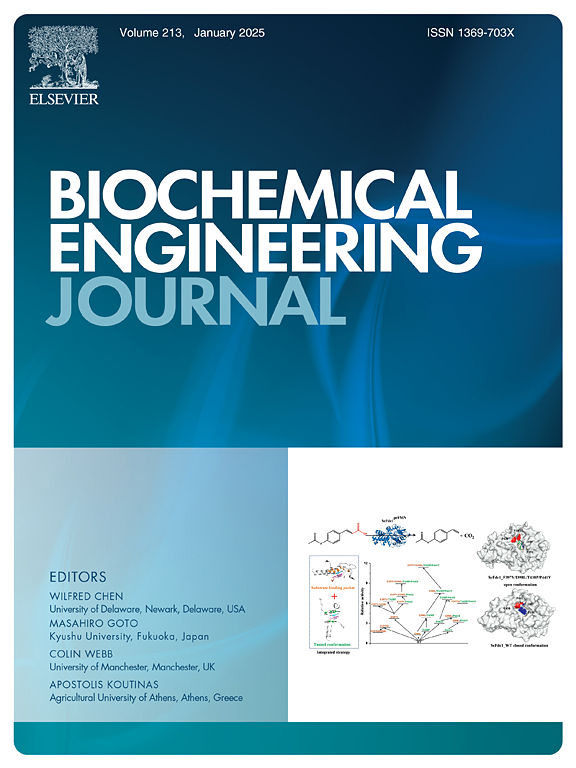Cooperative action from Cu-centered MOF and a laccase for enhanced decolorization of synthetic dyes
IF 3.7
3区 生物学
Q2 BIOTECHNOLOGY & APPLIED MICROBIOLOGY
引用次数: 0
Abstract
Laccases are highly versatile copper-dependent enzymes that can oxidize a broad range of substrates, with the combination of converting molecular oxygen to water. However, extreme conditions cause laccase instability, inactivation, and difficulty in its applications. Applying nanomaterials to natural laccase immobilization is essential for their applications as it allows their stabilization and easy recovery from the liquid reaction media and subsequent reuse. Here, we develop an ingenious method to cooperate the copper centers of a copper-based metal-organic framework (Cu-MOF) and a newly discovered laccase-LfLAC3 for effective decolorization of synthetic dyes. The immobilized enzyme presents excellent properties: the catalytic activity improved 62.6-fold, and the half-life (t1/2) at 60 °C increased more than 3-fold, indicating enhanced stability. The reusability was tested by monitoring the decolorization efficiency towards malachite green at 30°C and 60 °C, which demonstrated that the immobilized LfLAC3 can be reused more than ten cycles with more than 80 % removal at both temperatures through a simple centrifugation process. In addition, the detoxification of dyes after enzymatic treatment was also investigated by toxicity assessment. The structural characterization results indicated that copper centers of Cu-MOFs were evenly distributed in MOF-enzyme composites, affording synergistic effects for the catalytic functions. Our work highlights the potential of cooperating metal centers of MOFs and metal enzymes to generate catalysts with promising catalytic properties.
铜中心MOF与漆酶的协同作用增强了合成染料的脱色
漆酶是高度通用的铜依赖酶,可以氧化广泛的底物,将分子氧转化为水。然而,极端条件会导致漆酶不稳定、失活和应用困难。将纳米材料应用于天然漆酶固定化对于其应用至关重要,因为它允许它们稳定并易于从液体反应介质中回收并随后重复使用。在这里,我们开发了一种巧妙的方法,将铜基金属有机框架(Cu-MOF)的铜中心与新发现的漆酶lflac3合作,以有效地脱色合成染料。固定化酶表现出优异的性能:催化活性提高了62.6倍,60℃下半衰期(t1/2)提高了3倍以上,稳定性增强。通过监测在30℃和60℃下对孔雀石绿的脱色效率来测试其可重复使用性,结果表明,通过简单的离心工艺,固定化LfLAC3在两种温度下均可重复使用10次以上,去除率均在80% %以上。此外,还对染料经酶处理后的解毒作用进行了毒性评价。结构表征结果表明,cu - mof的铜中心均匀分布在mof -酶复合材料中,对催化功能具有协同作用。我们的工作强调了mof和金属酶的协同金属中心在制备具有良好催化性能的催化剂方面的潜力。
本文章由计算机程序翻译,如有差异,请以英文原文为准。
求助全文
约1分钟内获得全文
求助全文
来源期刊

Biochemical Engineering Journal
工程技术-工程:化工
CiteScore
7.10
自引率
5.10%
发文量
380
审稿时长
34 days
期刊介绍:
The Biochemical Engineering Journal aims to promote progress in the crucial chemical engineering aspects of the development of biological processes associated with everything from raw materials preparation to product recovery relevant to industries as diverse as medical/healthcare, industrial biotechnology, and environmental biotechnology.
The Journal welcomes full length original research papers, short communications, and review papers* in the following research fields:
Biocatalysis (enzyme or microbial) and biotransformations, including immobilized biocatalyst preparation and kinetics
Biosensors and Biodevices including biofabrication and novel fuel cell development
Bioseparations including scale-up and protein refolding/renaturation
Environmental Bioengineering including bioconversion, bioremediation, and microbial fuel cells
Bioreactor Systems including characterization, optimization and scale-up
Bioresources and Biorefinery Engineering including biomass conversion, biofuels, bioenergy, and optimization
Industrial Biotechnology including specialty chemicals, platform chemicals and neutraceuticals
Biomaterials and Tissue Engineering including bioartificial organs, cell encapsulation, and controlled release
Cell Culture Engineering (plant, animal or insect cells) including viral vectors, monoclonal antibodies, recombinant proteins, vaccines, and secondary metabolites
Cell Therapies and Stem Cells including pluripotent, mesenchymal and hematopoietic stem cells; immunotherapies; tissue-specific differentiation; and cryopreservation
Metabolic Engineering, Systems and Synthetic Biology including OMICS, bioinformatics, in silico biology, and metabolic flux analysis
Protein Engineering including enzyme engineering and directed evolution.
 求助内容:
求助内容: 应助结果提醒方式:
应助结果提醒方式:


